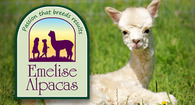Frequently Asked Questions (FAQs)
Alpacas are a domesticated member of the camelid family that also includes llamas, guanacos, and vicunas from South America.
Today there are about 2.5 to 3 million alpacas in the Andean highlands, most of which can be found in Peru, Chile and Bolivia. Since the first importation into the U.S. in 1984 their popularity has increased and are known for their luxurious fiber and investment potential throughout the United States, UK, Australia, Canada, most of Europe and other countries. Their gentle nature, manageable size and ease of care make them wonderful companion animals.
Alpacas were prized in ancient Incan civilization and have been domesticated for about 5000 years. There are two types of alpacas - the Huacaya (fluffy fleece with crimp) and the Suri (hanging fleece with no crimp). The lifespan of the alpaca is about 15-20 years and grow from 32"-39" at the withers, with a mature weight averaging about 150 pounds. Alpacas eat grasses and chew a cud. They have highly efficient digestive systems and require no special diet. They are gentle, easy to handle and safe, as they don't bite. They require minimal fencing and can be pastured at 6 to 8 per acre. Alpacas are shorn annually and depending on their location, require routine vaccinations to maintain health.
Breeding
Female alpacas are first bred at about 1 1/2 to 2 years of age and can be bred at any time of year. Gestation is approximately 340 days and at birth baby alpacas (crias) weigh from 13-20 pounds. Only one cria is born at a time. Twins are possible, but very rare. Male alpacas reach sexual maturity at about 2 1/2 to 3 years of age.
Fiber
Alpacas are shorn for their prized fiber. Alpacas can be seen at fiber festivals and alpaca shows across the United States. Colors range from of white, fawn, browns, black, grays, and multicolored and can easily be dyed. There are 26 shades recognized by the Alpaca Owners Association (AOA). The average alpaca yields about 6-10 pounds of fleece per year. Characteristics of fiber are crimp, density, fineness, handle, brightness and uniformity.
Diet
Alpacas are known as modified ruminants. While grazing on grass and free hay, depending on your location it may be necessary to supplement their diet with grain and or vitamins.
Demeanor
Alpacas are gentle and curious by nature and communicate mostly by a soft humming. Alpacas generally do not spit at people but may do so with each other to get a message across. They require the company of other alpacas, and will group together when alarmed or startled.
Tuesday, March 30, 2021

